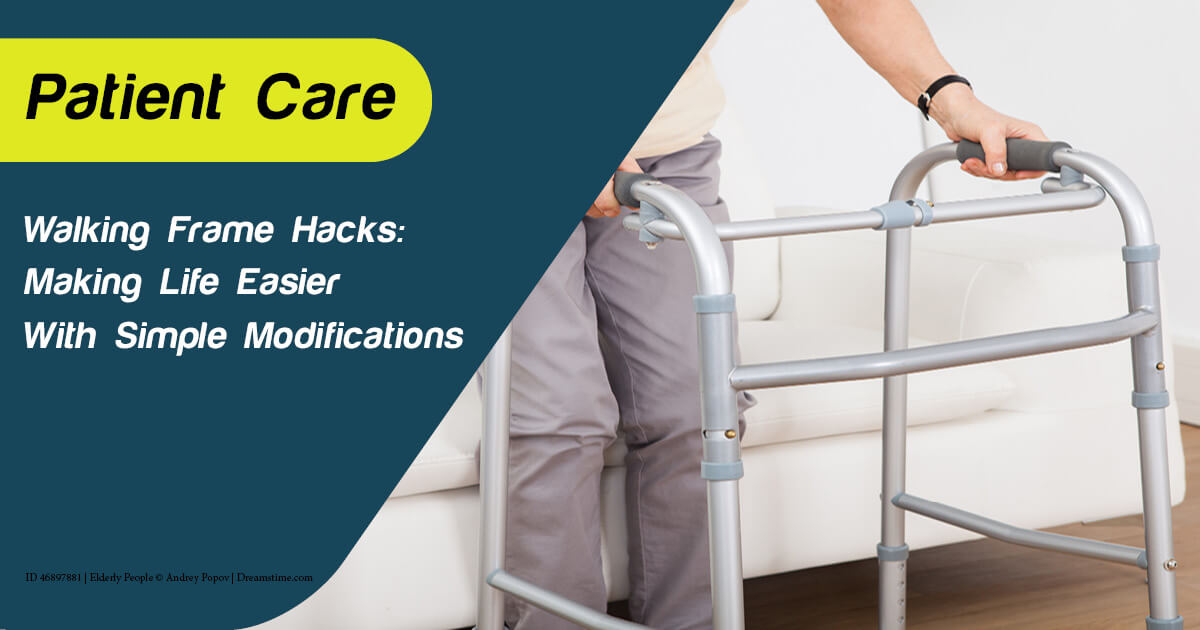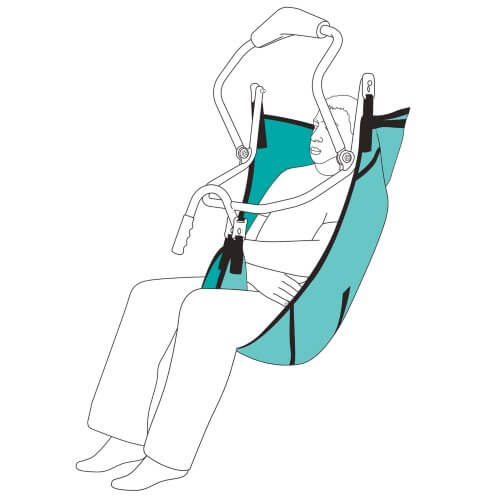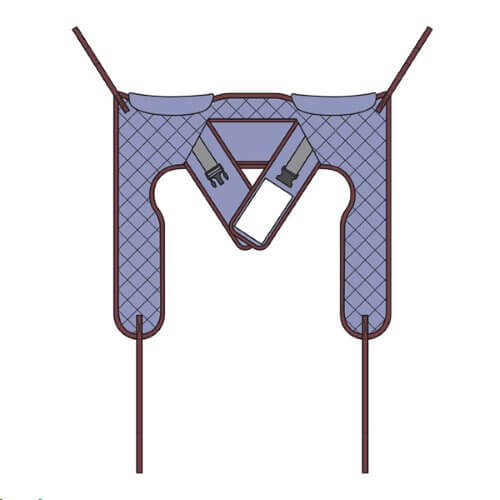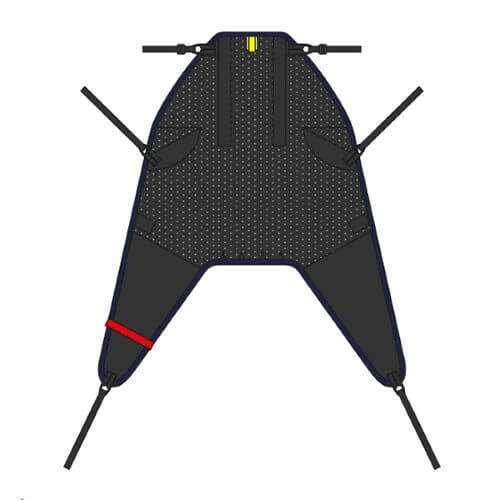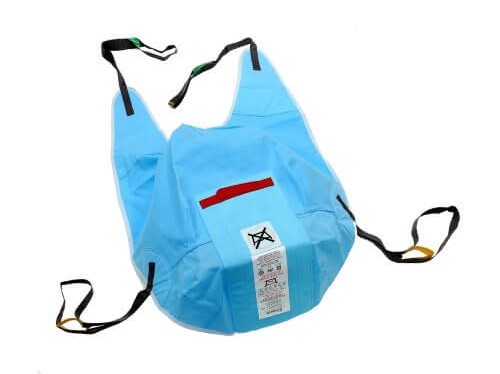
Share
When choosing a lifting sling, it’s important to find the right balance between patient comfort, safety, and the specific demands of care. Whether you're supporting someone with reduced mobility at home or assisting multiple patients in a professional setting, the right sling makes transfers smoother and safer for everyone involved.
In this guide, we’ll walk you through 8 common types of lifting slings and their purposes so you can make the best choice for your patient’s needs.
Please note, certain styles of slings may only be available in a loop or clip option (how they attach to the hoist) and specific fabric options. Consult with an Active Mobility representative to ensure your sling is compatible with the rest of your equipment and needs if you are unsure.
1. General purpose slings
General purpose slings are the most commonly used option for day-to-day transfers. They are well-suited to patients with moderate upper body control and can be used in a range of situations, such as moving a patient from a bed to a chair or assisting with general mobility needs.
For patients who require more stability during the lift, a version with head support will provide extra reassurance and comfort, particularly for those who may become fatigued or disoriented during transfers. Both mesh and fabric options are available — mesh is often preferred for bath use, while fabric may be more comfortable for extended wear.
2. Pivot slings
Pivot slings are designed for transfers where a more upright seated posture is required. They allow for smooth, controlled movement between sitting surfaces — making them particularly useful in rehabilitation, toileting, and postural management scenarios.
These slings are compatible with pivot frames or spreader bars that support this transfer style. The structured design and head support (available on some models) help ensure stability for patients who may struggle to maintain an upright position independently.
3. Toileting and hygiene slings
Hygiene slings offer specific design features that make toileting transfers quicker and more dignified. These slings typically have an open base or lower section to allow for clothing adjustments, while still providing enough support for a secure and safe lift.
Incorporating head and back support ensures that patients who need additional stability are still comfortably supported. Padded leg sections reduce pressure on sensitive areas, making these slings a valuable option for regular toileting needs in aged care or home care settings.
4. Amputee slings
Amputee slings are tailored for individuals who have had a lower limb amputation. Standard sling designs can create uneven pressure or instability, but amputee slings are designed to offer a more balanced and secure lift, minimising the risk of tipping or discomfort.
These slings provide targeted support around the pelvis and upper body, with adjustable leg sections that help accommodate differences in body shape. They are available in a range of sizes and configurations to ensure a safe fit for each individual.
5. Paediatric slings
Children and young people require slings that are scaled to their size but still offer the same high level of support and safety. Paediatric slings are carefully designed to fit the contours of a smaller body and reduce pressure around sensitive areas.
These slings are often used in schools, hospitals, and rehabilitation centres. Models like the Tinkham Sling include additional features such as a thoracic wrap-around and padded head support — ideal for children with complex mobility needs or extensor tone issues.
6. Rehabilitation and walking slings
Rehabilitation slings support upright posture during walking or standing training. They are designed to partially bear the patient’s weight, which encourages movement while reducing the risk of falls. They are frequently used in rehabilitation programs after surgery, stroke, or periods of immobility.
Walking slings like the Ergo or Walking Harness provides adjustable support around the torso and under the legs. This allows carers and physiotherapists to adapt the sling to each patient’s capabilities, helping them gradually build strength and confidence.
7. In-situ slings
In-situ slings are made from breathable, low-friction materials that allow the sling to remain in place after a transfer is completed. This is particularly helpful for patients who require frequent repositioning or who are unable to tolerate repeated sling fittings.
In palliative care and long-term seating scenarios, in-situ slings reduce the need to disturb the patient unnecessarily. Their soft construction helps prevent pressure injuries and skin shearing, while still offering reliable support for transfers.
8. Single use slings
Disposable or single patient use slings are an important option for maintaining hygiene in clinical environments. They’re designed for short-term or one-off use, such as during hospital admissions, infectious disease outbreaks, or in settings where washing and reusing slings may not be practical.
These slings help prevent cross-contamination and are available in a variety of styles — including loop and clip attachments — to ensure compatibility with different hoists. Bariatric sizes are also available to support higher weight capacities when needed.
Safety tips for patient lifting slings

ID 16301469 © Nyul | Dreamstime.com
Once you’ve selected the right sling, it’s just as important to ensure safe use during transfers. Proper technique protects both the patient and the carer and helps reduce the likelihood of injury or discomfort.
Here are some practical tips to keep in mind:
Check for wear and tear
Inspect the sling for damage before every use. Frayed edges, broken stitching, or worn straps can all compromise the safety of a transfer. If you notice any faults, the sling should not be used.
Always follow the instructions
Each sling has a designated safe working load (SWL) and a specific method of attachment. Familiarise yourself with the user guide and check that your hoist is compatible with the sling’s loop or clip system.
Fit the sling properly
Take care to position the sling evenly and adjust the leg and back sections so they’re aligned with the patient’s body. Poor positioning can lead to instability during the lift or pressure on vulnerable areas.
Communicate with the patient
Whether the patient is verbal or non-verbal, talking them through the process is essential. Let them know what to expect, pause if they show discomfort, and involve them in the process where possible.
Lift slowly and steadily
Avoid sudden movements. Raising the patient gradually allows time to make any adjustments and helps them feel more secure throughout the transfer.
Need help choosing the right sling? We're here to help

ID 39622552 © Attila BarabA!s | Dreamstime.com
With such a wide range of slings available, it can be difficult to know where to start. We’re here to guide you through the process — whether you're purchasing for a hospital, care home or private residence.
At Active Mobility, we stock over 40 different sling models designed for a wide range of scenarios, from everyday general use to specialised rehabilitation or hygiene support. Our team can help you choose a sling based on the user’s mobility level, body type, and transfer requirements. We also offer custom sizing, Australia-wide shipping, and in-store demonstrations to give you complete confidence in your purchase.
Explore our full range of lifting slings online, or book a showroom appointment to speak with one of our mobility experts.


